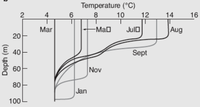
Photo from wikipedia
This study simulated the generation and evolution of saltwater turbulence within a water tank. By pouring fresh water over saltwater in the tank, a layer of saline water with a… Click to show full abstract
This study simulated the generation and evolution of saltwater turbulence within a water tank. By pouring fresh water over saltwater in the tank, a layer of saline water with a fixed gradient was created. Convective turbulence was then formed by heating the bottom of the tank. The temperatures at different heights were measured using eight thermocouples; thus, the average temperatures and temperature fluctuations at different heights were calculated. The salinity profile was obtained by moving a conductivity probe up and down to measure the conductivity. Two-dimensional light intensity grayscale images were recorded after transmitting a collimated laser beam through the water tank, after which the normalized variance and power spectra of the light intensity fluctuations at different heights were calculated. The results showed that the saltwater in the tank could be divided by height into two layers, namely, the mixed layer and entrainment zone, according to the profiles of the average temperature and average salinity under the experimental conditions. Different portions of the images showed different characteristics. The part corresponding to the saltwater mixed layer was similar to that corresponding to the mixed layer in the fresh water experiment. However, a two-peak structure was observed in the curve of the normalized light intensity spectrum calculated from the grayscale values in the part corresponding to the bottom of the entrainment zone, whereas a two-peak structure was not found in the light intensity fluctuation spectrum corresponding to the mixed layer. According to the refractive index fluctuation spectrum model, one peak was due to temperature fluctuations, and the other peak was due to salinity fluctuations. It can be concluded that the salinity contribution to the refractive index fluctuation in the entrainment zone was larger than that in the mixed layer. Moreover, spectral analysis showed that in the saltwater, the inner scale of turbulent temperature fluctuation was approximately 1.9 mm, while the inner scale of turbulent salinity fluctuation was approximately 0.1 mm. These findings will be helpful for us to understand the microstructural characteristics of seawater turbulence and guide the implementation of optical transmission experiments in seawater.
Journal Title: Optics express
Year Published: 2018
Link to full text (if available)
Share on Social Media: Sign Up to like & get
recommendations!